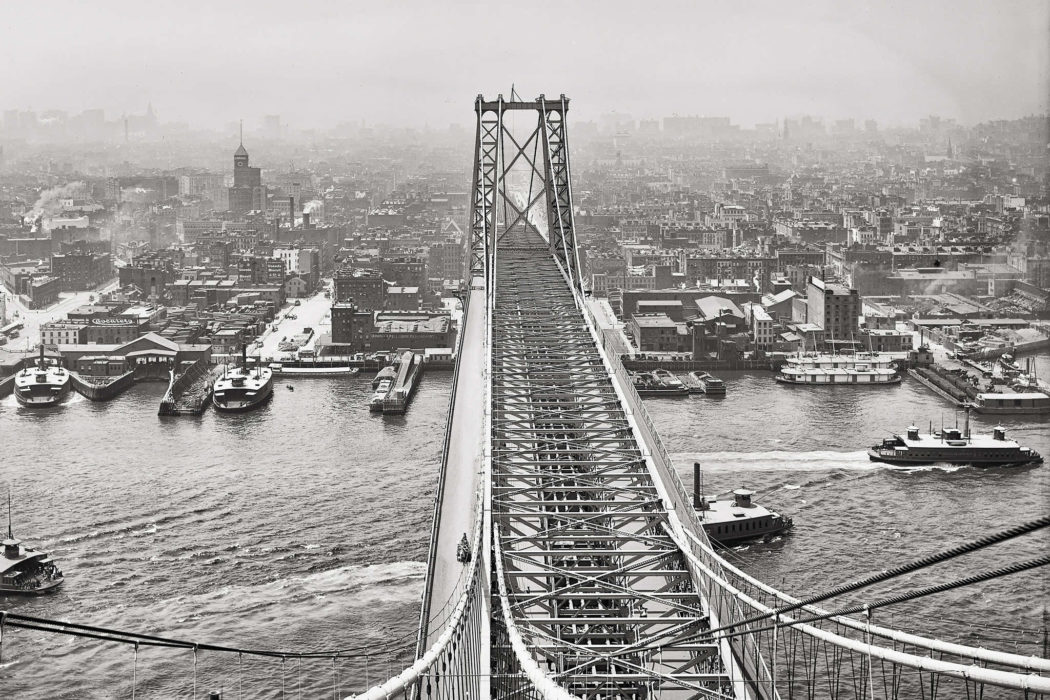THE CITY WAS ON the move. Thousands of people streamed across the East River, over the Williamsburg Bridge toward Brooklyn. It was rush hour, and they were walking home after a long workday in the factories and workshops, the laundries, shops, and offices of Manhattan.
New York is a “beehive,” a reporter heard ‘Abdu’l-Bahá say. He watched the marching masses through the left, backseat window of his car as it sped back across the bridge to Manhattan. To the southeast, beneath the afternoon sun, he could see the new battleship, the USS New York, in dry dock at the Brooklyn Navy Yard. They had laid her keel last September. Her shiny hull flashed in glimpses through the trusses of the bridge like a motion picture film.

‘Abdu’l-Bahá had just addressed a private audience of 300 people at the home of Howard and Mary MacNutt at 935 Eastern Parkway, a major east-west artery in Brooklyn. He had spoken from the bright stairway beneath a stained-glass window — the only redeeming feature in a reputedly ugly house. He had talked of war.
Peace, after all, was one of the reasons ‘Abdu’l-Bahá had come to America.
“Consider the sad picture of Italy carrying war into Tripoli,” he had said. “If you should announce that Italy was a barbarous nation and not Christian, this would be vehemently denied. But would Christ sanction what they are doing in Tripoli?”
It was a friendly crowd: some of them were Bahá’ís.
“No less bitter is the conflict between sects and denominations,” he continued. “To be a Christian is not merely to bear the name of Christ and say, ‘I belong to a Christian government.’ To be a real Christian is . . . to go forth under his banner of peace and love toward all mankind, to be self-sacrificing.”
To illustrate, ‘Abdu’l-Bahá drew an analogy between human society and the structure of matter. “If the atoms which compose the kingdom of the minerals were without affinity for each other,” he said, “the universe could not have been created. When this attraction or atomic affinity is destroyed, the power of life ceases to manifest; death and nonexistence result.”
“The purpose of man’s creation is, therefore, unity and harmony, not discord and separateness.”
The Manhattan end of the Williamsburg Bridge empties onto Delancey Street in the East Village, and here the car now stopped. Dozens of children approached to find out who this man was with the grey beard and the strange clothes. Then they turned north on Bowery, rode through the late afternoon shadows beneath the rumble and clack of the 3rd Avenue El trains, visited the Cooper Union’s ornate brownstone, and, after a few more stops, motored back up Broadway to the Hotel Ansonia at 73rd Street, where ‘Abdu’l-Bahá resided. The drive had made him happy; he told the reporter that he was “beautifully tired.”

The story of the USS New York, however, did not end happily. She died from friendly fire at the age of thirty-six. After escorting President Wilson to the Paris Peace Conference in 1919, attending King George VI’s coronation in 1937, and firing more shells at Iwo Jima than any other ship, she was put out to pasture in 1946 as a target ship for the nuclear tests at Bikini Atoll. She survived two blasts, was hauled to Pearl Harbor, was poked and prodded for two years while they studied her reactions. Then, in 1948, they towed her forty miles southwest of Pearl to be used for target practice by American navy aircraft and artillery.
She sank under bombardment at 2:30 p.m. on July 8, 1948, and there she still rests, at the bottom of the Pacific Ocean, still consumed in the afterglow of atomic radiation.






